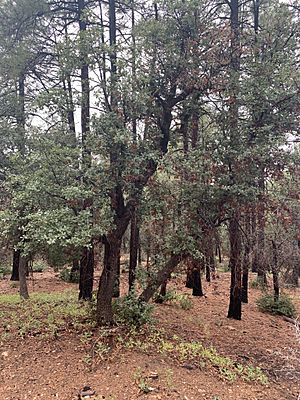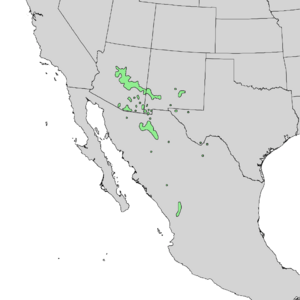Arizona white oak
Quick facts for kids Arizona white oak |
|
|---|---|
 |
|
| Conservation status | |
| Scientific classification | |
| Genus: |
Quercus
|
| Species: |
arizonica
|
 |
|
| Synonyms | |
|
|
The Arizona white oak (also known as Quercus arizonica) is a type of tree found in North America. It belongs to the beech family. You can find this tree growing in places like Arizona, New Mexico, and western Texas in the United States. It also grows in parts of Mexico, including Sonora, Chihuahua, Coahuila, Sinaloa, and Durango.
Contents
What Does It Look Like?
The Arizona white oak is one of the biggest oak trees in the southwestern United States. This tree can grow up to 60 feet (18 meters) tall. Its trunk can be about 3.3 feet (1 meter) wide. It has strong branches and a wide, spreading top, called a crown.
Its leaves are about 3.2 inches (8 cm) long. They are thick and stay green all year round, which means they are evergreen. Once the tree is fully grown, it grows very slowly. It only adds about 0.1 inches to its width each year.
Tree Parts
- Bark: The bark is light grayish. When the tree is young, the bark is thin. As it gets older, it becomes quite thick. It has shallow cracks and scaly ridges.
- Twigs: The twigs are medium-sized and fuzzy. They can be light brown or reddish brown. The ends of the twigs have pointy, fat groups of buds.
- Leaves: The leaves grow one after another along the stem. They are evergreen, simple, and shaped like an oval. Their color can be yellowish-green or bluish-green. Leaves are usually 1.5 to 3.5 inches long. Their edges are usually smooth or have small teeth. The base of the leaf is rounded. The leaves feel leathery and stiff. The veins on the leaves are parallel. They look sunken on the top side and raised underneath. Leaves might fall off in late winter or when new leaves grow in the spring.
- Fruit: The fruit is an oval-shaped acorn, about 0.5 to 1 inch long. Acorns have caps that look like bowls. These caps cover about one-third of the nut. Acorns usually become ripe in the autumn. The number of acorns a tree produces can change a lot each year. One year it might make about 32,000 acorns, and the next year very few. Acorns are more likely to sprout if there is enough moisture during the rainy season.
- Flowers: The Arizona white oak has both male and female flowers on the same tree. This is called being monoecious. Female flowers are small spikes that grow where the leaves meet the stem. Male flowers are long, hanging, yellowish-green catkins.
Where Does It Grow?
The Arizona white oak can be found in many different places. These include savannas (grassy areas with scattered trees), grasslands, and chaparrals (areas with dense shrubs). They usually grow in mountain areas. These areas are often higher than about 1,675 meters (5,495 feet) above sea level.
This tree does not need a lot of water. It needs full sun or some shade to grow well. The soil should be dry and can be rocky or sandy. It can also grow in clay loam, clay, or medium loam soils. The Arizona white oak can handle both hot and cold weather.
What Are Its Threats?
A type of wood-rotting fungus called Inonotus andersoni can harm the Arizona white oak. Also, controlled burning and using herbicides (chemicals to kill plants) have affected how these trees grow. Because of this, people are managing them using special forestry methods called pinyon-juniper silvicultural systems. These systems help protect the trees.
How Is It Used?
The wood from the Arizona white oak is often used for fuel, like firewood. The wood is very hard, heavy, and strong. Because of this, it is not often used for making furniture or other commercial products.
The Arizona white oak provides shelter for many animals. These include deer, turkeys, javelinas, desert sheep, songbirds, and quail. White-tailed deer also use it for cover. Both white-tailed and mule deer find the Arizona white oak very tasty to eat. The only animal known to eat a lot of its acorns is the thick-billed parrot.
The Arizona white oak can also be planted as an ornamental plant. This means people grow it in gardens or parks because it looks nice.
See also
 In Spanish: Encina Arizona para niños
In Spanish: Encina Arizona para niños


